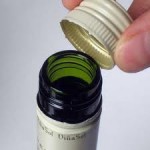Screw It!

By Michael Siegel
There are many modern marvels–Iphone5, 3D printing, cars that park themselves, the list goes on and on. Could screw caps for wine bottles be another modern marvel? Often referred to as Stelvin closures, a shortened version of Stelcap-vin (the name used by a French company who began releasing them for use in 1959), screw caps have a history of being associated with cheap wines–Almaden Chablis, Gallo Red Burgundy, and cooking wines to name a few. Undoubtedly, there are some serious perception issues for the mighty metal top; however, their use is definitely on the rise, with many winemakers in the U.S. and abroad experimenting with them on select wines.

I came to the realization that screw caps were here to stay when a case of Plumjack McWilliams Oakville Estate Cabernet Sauvignon I ordered came in a beautiful wooden case with…screw caps–at $350 per bottle, I was more than just a little surprised! With tainted corks ruining so many wines–disappointing consumers and costing winemakers millions in the process–many in the wine business sought to find alternative closures. The wine industry estimates between 3% and 7% of all wines are contaminated with Trichloroanisole, commonly referred to as TCA, at levels that can be detected by consumers. In a 30-month study comparing natural and synthetic cork closures with the screw caps, the findings suggest significant benefits in utilizing screw caps over either natural or synthetic cork closures. Screw caps not only can provide a great seal for bottled wines and protect against oxidation, they are a great defense against the occurrence of “corked” wines (though contamination is still possible during the winemaking process). While screw caps do diminish the romantic ritual of bottle presentation, it is well worth the sacrifice to ensure a taint-free wine that offers consistent aging, maintenance of flavor and freshness, and optimum quality control.
Aug 30, 2013